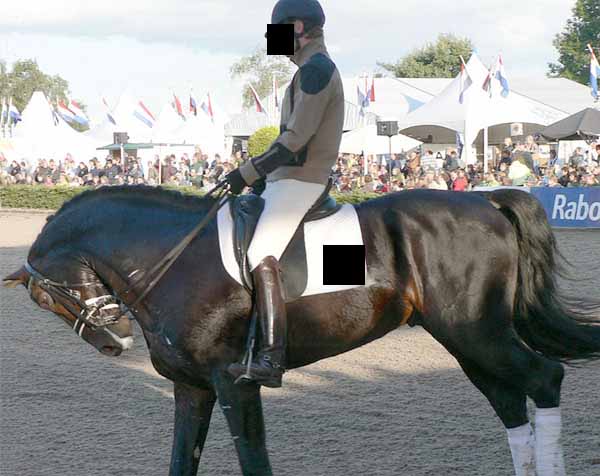On Rollkur...
...Deep'n'Round and Methods of Overbending in Modern Dressage Training
The Pros and Cons. Or Just Cons, Basically...

Deep...
This is a collection of articles discussing the necessity and validity of the theory of riding dressage horses deep, round and overbent for training purposes. It deals with what it actually is, what it's supposed to do, and the apparent downsides to the method. I have not attempted to be "objective" about the subject, and it is rather evident from the texts that this is not a method I use myself.
Contrary to many's beliefs, however, I have tried all the different techniques, except one, deep and extremely bent to the side,
nose to boot in medium gaits. This is where I feel my limit is for trying odd and potentially harmful things out an another living being. I will just have to live with not knowing how that particular exercise feels.
Science...
Nor have I tried to write a scientific paper on the subject. I have references to quotes and a bibliography. I have support from some prominent people in the dressage world, but and most of the conclusions are ones that I have reached myself by experimentation and observation, asked vets and trainers, and not to mention done some rational thinking.
Classical?
The main discussion in these articles is on biomechanics and biodynamics of the horse. There are many other issues to discuss, one being whether this is "classical" or not. The problem with that is that the word classical is not really defined and has been used and misused so much that no-one knows what it stands for, anymore. Most adherers stick to what "The Masters of Old" said was right. But what masters? Does one adhere to Xenophon, De la Gueriniere or The first FEI comittee that wrote the first rules for competition in 1920? Sadly, those fine and thought-through first rules of competition are being changed bit by bit to fit better into the modern sport, and how it actually look in the arena, rather than changing the training and riding to fit the rules.
A Sign of the Times
Times and ideals change, and in sports medicine nowadays therapists are more concerned with stretching than they used to be. And that has done sports a lot of good, no doubt about that. Also society has changed from authoritarian "Never behind the vertical!" to a more scientific "Behind the vertical makes the horse..." We now look for the reason the masters hollered.
Before dressage became a sport it was a duty (the army) or and art (noblemen). In the army, soldiers could learn to ride or die trying. Artwise, the noblemen took pride in practising the art as closely to their ideals as possible. And since you have only yourself too fool, they sought and tried to be better all their riding lives.
In the modern sports world there is no such self-regulatory system. We have outside evaluation, rules and judges for competitions, and for winning you work on impressing the judges to judge you favourably and hopefully according to the rules. But horses and riders are all different, and judges, too. Rules written in words cannot be superimposed on a living form of art. So scores depends on how a judge interprets the rules, how he perceives the horse, and on the flavour of the month...
The rules of the FEI represent the same ideal as both German and French army cavalry schools abided by, and probably the same as the noblemen of old held as theirs. Alarmingly, they have started to change the rules quite a bit lately. Why would that be necessary? Horses have hardly changed. They still have four legs, and derive from carriage horses and thoroughbreds. What has changed, is the selection of people attempting to become dressage riders and competitors.
Perfect Scores and Perfect Riding
As in any sport, we want to start young and rise to the top early to be able to stay there longer. To take time to learn every discipline of horsemanship, and to try to find teachers, both horses and humans, skillful enough to be able to teach rhythm, relaxation, suppleness, balance, contact, straightness, collection, and throughness in it's ultimate form seems obsolete. Inherent gaits, control, tricks and precision is what is rewarded in competition rather than the quality of the criteria of the training scale. If 12-15 steps of piaffe is demanded at X, a so-so execution of 15 consecutive shuffles at X is rewarded higher than a fluid, elevated piaffe of 10 steps 3 meters after X. And in a test, rightfully so! There's a description to ride by. If all and sundry rode the movements anywhere they wanted, all could do great, well prepared piaffes, right? So what happens in the freestyle to music..?
The precision and succession of tricks of modern dressage tests are somewhat above the ability of a 22 year old who rides and studies for a degree and still wants to compete at GP. So we devise training methods that give us precise control of the horse down to the millimetre, and we sacrifice balance and correctness in the process. Since perfection is not the goal - perfect scores are.
 /Theresa /Theresa
|

